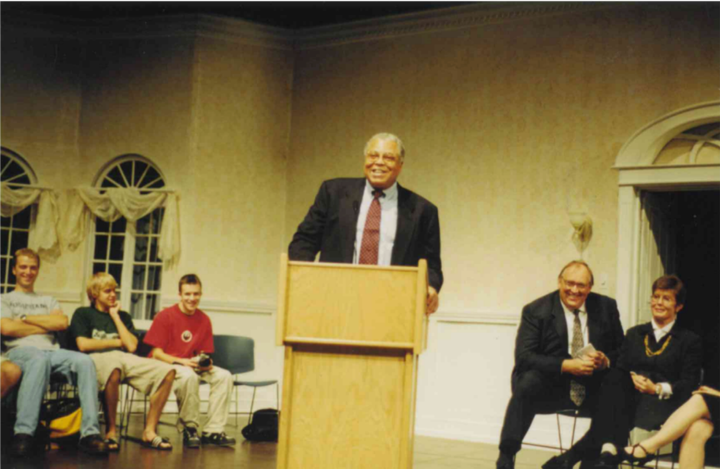Eide/Dalrymple Gallery celebrates 500 since Reformation
JESSICA RUF
jnruf15@ole.augie.edu
Commemorating 500 years after Martin Luther nailed his 95 theses to the door of the Catholic church, 22 artists display their interpretation of the Protestant Reformation in Augustana University’s Eide/Dalrymple Gallery.

Ranging from crafty expressions of cultural pride to abstract portrayals of critical social issues, the gallery is an eclectic but thought-provoking collection on how people from across the nation (primarily the Midwest) understand the meaning of “reformation.”
One of the first pieces in the exhibit is an oil painting on a small, wooden plate by Susan Hovdenes Hooyer. With a black cross in the center of a white flower, surrounded by a blue and yellow border, the plate is a reproduction of the Luther seal. However, Hooyer adds her own interpretation to the emblem by using Norwegian rosemaling technique to capture the already present curves and floral pattern.
The product, though exceedingly simple, captures the rustic Norwegian heritage attached to the Lutheran tradition in the Midwest. At first glance, the painted plate might seem mundane or even boring —as it originally did to me—but its simplicity speaks volumes to the humility and modesty often associated with Lutheranism.
Other homemade-looking pieces in the exhibit, however, were far less effective. Both “Fabric Luther Rose,” by Kristine A. Luber (a replication of the Luther seal made of felt and velvet) and “Church Ladies,” also by Luber (a fabric patchwork with embellishments), looked more like homemade decorations for a church basement, rather than pieces on display at an art gallery.
Far at the opposite end of the spectrum, are Jenny Bye’s masterful abstract paintings made with melted, colored beeswax. Bye specializes in this style of medium called encaustic painting. Her displayed works primarily feature darker colors of cloudy blues, deep blacks, and blood reds.

“Reformation Three,” resembles a murky, gray web, alluding to the selfish corruption within the Catholic church at the time while “Reformation Two” encapsulates Luther’s isolation by featuring a dark, blurred figure looking out a window. In “Reformation One,” inky silhouettes of people streak downward as though the painting has been left out in the rain.
The three works of Bye’s don’t necessarily make specific social statements, but rather, they elicit emotion, such as feelings of chaos, pensive melancholy, and cleansing redemption. The abstractness of her work gives the observer more room for interpretation.
Contrasting Bye’s darker themes, Dede Farmer uses bright blues, golden hues of orange and shining yellows to create an atmosphere similar to that of a springtime farm, or in other words, an atmosphere of birth and renewal in her painting “Allegory of the Artist.” A hand in the middle of the painting displays an egg as two Gatsby-like eyes watch from an opening in the blue sky. Meanwhile, a brown rabbit and rooster stare at one another in the foreground. Stocked full of Christian symbolism and beams of light shining from all directions, the painting reminds one of a stained glass window.
Other works in the gallery were not as symbolic or abstract, but addressed specific issues of today. The most powerful of these works were Linda Friedman Schmidt’s portraits made of discarded clothing. In her piece titled “Wall,” Schmidt confronts issues of religious bigotry by weaving a hasidic Jewish man gazing past a barrier towards a Muslim woman. Both have deep, expressive eyes and mournful gestures. By using scraps of clothing as her medium, Schmidt powerfully emphasizes the man and woman’s equality as human beings.
Other pieces in the gallery include a small collection of local photography pertaining to issues of class inequality, a Louis Vuitton shrine criticizing consumerism, a watercolor foldout book on bamboo paper and a large three panel woodcut, celebrating the achievements of the Gutenberg Press.
Lutheran or not, the assorted mixture of mediums, styles, and interpretations is sure to have works that will both resonate and perhaps challenge one’s view of reformation.
To Reform: Artists Respond to the Reformation will be exhibited until Nov. 18 at the Eide/Dalrymple Gallery. Entrance is open and free to the public.



